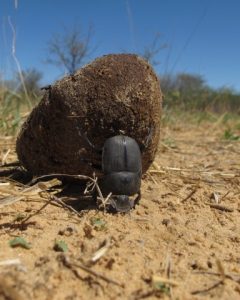Compass orientation in ball-rolling dung beetles
Basil el Jundi1 and Marie Dacke2
1University of Würzburg, Biocenter, Zoology II, Germany and 2Lund University, Department of Biology, Lund Vision Group, Sweden
Many insects are remarkable navigators, confidently moving between a food source and their home. Dung beetles have developed a different, and unique, orientation behavior to avoid competition for food; they simply pack their food up into a ball and move it away from the dung pat. To effectively escape along a straight path (that maximizes the distance between the beetle and the pat), these insects rely on the sun, the moon, the spectral and intensity gradient of the sky, the celestial polarization pattern and the Milky Way for orientation. Some of these compass cues are more reliable than others, and not all of them are available at any given moment in time. This raises the question of how animals define the relative relevance of different compass cues.
To formulate an understanding of how the beetles orient along their straight escape routes, we study their behavior and brain activity. We find that the relative relevance of the different celestial cues varies between species and time of day. This cue hierarchy seems to be defined prior to rolling, at the moment when a beetle dances on top of its ball and takes a snapshot of the sky. We further find that neurons of the central complex, a centrally placed brain region, encode celestial compass cues. This makes them perfectly suited to form a neural network to encode this celestial snapshot, a key component in the guidance of the escape from the busy dung pat.









You must be logged in to post a comment.